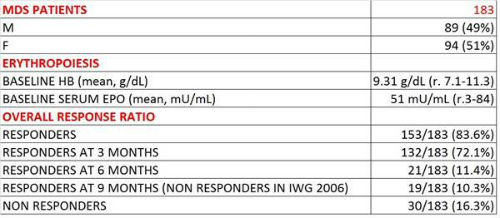
Contributions
Abstract: PB1923
Type: Publication Only
Background
Erythropoiesis stimulating agents (ESAs) are the frontline treatment in low-risk anemic MDS patients and an employment of this therapy in the earlier stage of the disease can delay the need for RBC transfusion, hypothetically by slowing the disease course. It’s matter of debate whether the clinical response is a result of proliferation and maturation of the dysplastic clone or stimulation of residual normal erythropoiesis by ESAs.
Aims
Macrocytosis is one of the cytological hallmarks of dyserithropoiesis in MDS: an analysis of the erythropoietic response to ESAs therapy in a cohort of anemic non trasfusion-dependent MDS patients, enrolled in a retrospective register, RECAMDS, subgroup of Italian register, was performed.
Methods
183 patients, treated with standard-dose ESAs, have been retrospectively analyzed (Table 1). Data analysis was performed, according to IWG 2006 criteria, at the baseline, after 3 and 6 months of continuous treatment, with a subanalysis of the patients according to WHO and R-IPSS risk stratification. ESAs were started at mean Hb concentration of 9.31 g/dl, mean serum EPO concentration: 51 mU/L, after a mean time from diagnosis of 6 months (r.1-118).
Results
Overall response rate(ORR) was 83.6% (153/183), no difference among WHO and IPSS subgroups was found: 132/183 (72.1%) achieved response after 3 months of treatment, while other 21/183 (11.2%) after 6 months. 19 patients with stable disease (non-responders, according to IWG criteria), in which treatment was continued, achieved response after 9 months. In the macrocytic-responders group 83.2% exhibits again macrocytosis after 3 months, while 16.8% become normocytic. In the normocytic-responders group 89.8% exhibits again normocytosis, while 10.2% become macrocytic: in these patients, after 3 months, there was a contemporary worsening in neutropenia and thrombocytopenia, with transfusion-dependence, regarded as first signs of progression of disease. Non-responders were 30/183 (16.3%): in the macrocytic non-responders group 89% exhibit again macrocytosis after 3 months, while 11% become normocytic; in the normocytic group 76% exhibits again macrocytosis, while 24% become normocytic.

Conclusion
These preliminary data can suggest that, in the majority of MDS patients responsive to ESAs, the increase of Hb concentration occurs mainly stimulating erythroid production in MDS clones; in the minority of patients probably it happens recruiting residual polyclonal erythropoiesis. It is interesting to note that stimulating effects of ESAs last even when the expression of dysplasia progresses.
Session topic: 10. Myelodysplastic syndromes - Clinical
Keyword(s): Myelodysplasia, Erythropoietin, Erythropoieisis
Abstract: PB1923
Type: Publication Only
Background
Erythropoiesis stimulating agents (ESAs) are the frontline treatment in low-risk anemic MDS patients and an employment of this therapy in the earlier stage of the disease can delay the need for RBC transfusion, hypothetically by slowing the disease course. It’s matter of debate whether the clinical response is a result of proliferation and maturation of the dysplastic clone or stimulation of residual normal erythropoiesis by ESAs.
Aims
Macrocytosis is one of the cytological hallmarks of dyserithropoiesis in MDS: an analysis of the erythropoietic response to ESAs therapy in a cohort of anemic non trasfusion-dependent MDS patients, enrolled in a retrospective register, RECAMDS, subgroup of Italian register, was performed.
Methods
183 patients, treated with standard-dose ESAs, have been retrospectively analyzed (Table 1). Data analysis was performed, according to IWG 2006 criteria, at the baseline, after 3 and 6 months of continuous treatment, with a subanalysis of the patients according to WHO and R-IPSS risk stratification. ESAs were started at mean Hb concentration of 9.31 g/dl, mean serum EPO concentration: 51 mU/L, after a mean time from diagnosis of 6 months (r.1-118).
Results
Overall response rate(ORR) was 83.6% (153/183), no difference among WHO and IPSS subgroups was found: 132/183 (72.1%) achieved response after 3 months of treatment, while other 21/183 (11.2%) after 6 months. 19 patients with stable disease (non-responders, according to IWG criteria), in which treatment was continued, achieved response after 9 months. In the macrocytic-responders group 83.2% exhibits again macrocytosis after 3 months, while 16.8% become normocytic. In the normocytic-responders group 89.8% exhibits again normocytosis, while 10.2% become macrocytic: in these patients, after 3 months, there was a contemporary worsening in neutropenia and thrombocytopenia, with transfusion-dependence, regarded as first signs of progression of disease. Non-responders were 30/183 (16.3%): in the macrocytic non-responders group 89% exhibit again macrocytosis after 3 months, while 11% become normocytic; in the normocytic group 76% exhibits again macrocytosis, while 24% become normocytic.

Conclusion
These preliminary data can suggest that, in the majority of MDS patients responsive to ESAs, the increase of Hb concentration occurs mainly stimulating erythroid production in MDS clones; in the minority of patients probably it happens recruiting residual polyclonal erythropoiesis. It is interesting to note that stimulating effects of ESAs last even when the expression of dysplasia progresses.
Session topic: 10. Myelodysplastic syndromes - Clinical
Keyword(s): Myelodysplasia, Erythropoietin, Erythropoieisis


